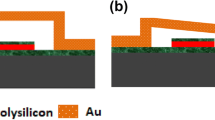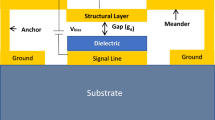Abstract
This paper presents a dielectric material selection methodology for RF-MEMS switch used for radio frequency applications. Here Ashby’s material selection approach is used to optimize the performance indices of RF-MEMS switch such as dielectric charging, stability, hold down voltage and RF performance. In this work, dielectric constant (ɛ r), electrical resistivity (ρ), thermal conductivity (λ), thermal expansion coefficient (α), Young’s Modulus (E) are chosen as material indices of dielectric layer in RF-MEMS switch to evaluate the various performance indices. The Ashby’s material selection charts shows that Al2O3 and SiN are the best suitable material for dielectric layer in RF-MEMS switches to exhibit improved performance for radio frequency applications.







Similar content being viewed by others
References
Ashby MF (1999) Materials selection in mechanical design, 2nd edn. Butterworth-Heinemann, Oxford
Cetiner BA, Crusats GR, Jofre L, Bıyıklı N (2010) RF MEMS integrated frequency reconfigurable annular slot antenna. IEEE Trans Antennas Propag 58(3):626–632
Gallot-Lavallee O (2013) Dielectric materials and electrostatics. Wiley, New Jersey
Jung CW, Lee M-J (2006) Reconfigurable scan-beam single-arm spiral antenna integrated with RF-MEMS switches. IEEE Trans Antennas Propag 54(2):455–463
Jung CW, Lee M-J, Flaviis F (2008) Reconfigurable dual-band antenna with high frequency ratio (1.6:1) using MEMS switches. IEEE Electron Lett 44(2):76–77
Kar S (2013) High permittivity gate dielectric materials: Springer series in advance microelectronics, vol 43. Springer, Heidelberg
Luo JK, Lin M, Fu YK, Wang L, Flewitt AJ, Spearing SM, Fleck NA, Milne WI (2006) MEMS based digital variable capacitors with a high-k dielectric insulator. Sens Actuators A 132:139–146
Muldavin JB, Rebeiz GM (2000) High-Isolation CPW MEMS switches: part 1: modeling. IEEE Trans Micro Tech 48(6):1045–1052
Nirmal D, Vijayakumar P, Shruti K, Mohan KN (2013) Nanoscale channel engineered double gate MOSFET for mixed signal applications using high-k dielectrics. Int J Circuit Theory Appl 41(6):608–618
Pacheco SP, Nguyen CT, Katehi LPB (2000) Design of low actuation voltage RF MEMS switch. IEEE MTT-S Int Microw Symp Dig 1:165–168
Papaioannou G (2010) The impact of dielectric material and temperature on dielectric charging in RF-MEMS capacitive switches. In: Advanced materials and technology for micro/nano-devices, sensors and actuators. Springer Science, pp 141–153
Papandreou E, Crunteanu A, Papaioannou G, Blondy P, Dumas-Bouchiat F, Champeaux C, Catherinot A (2008) Investigation of dielectric charging mechanisms in Al2O3 RF MEMS capacitive switches. In: International conference MEMSWAVE 2008
Parate O, Gupta N (2011) Material selection for electrostatic microactuators using Ashby approach. Mater Des 32(3):1577–1581
Rebeiz GM (2003) RF MEMS: theory, design, and technology, 3rd edn. Wiley, New Jersey
Reddy GP, Gupta N (2010) Material selection for microelectronic heat sinks: an application of the Ashby approach. Mater Des 31:113–117
Sharma AK, Gupta N (2012) Material selection of RF-MEMS switch used for reconfigurable antenna using Ashby’s methodology. Prog Electromagn Res Lett 31:147–157
Sharma AK, Gupta N (2014) Investigation of actuation voltage for non-uniform serpentine flexure design of RF-MEMS switch. Microsyst Technol 20(3):413–418
Sharma AK, Gupta N (2015) Electromagnetic modeling and parameter extraction of RF-MEMS Switch. Microsyst Technol 21(1):181–185
Smith AGH (2011) Structural and defect properties of strontium titanate. Ph.D. Thesis, Department of Chemistry, University of London
Vinoy KJ, Vardan VK (2001) Design of reconfigurable fractal antennas and RF-MEMS for space-based systems. IOP Smart Mater Struct 10(6):1211–1223
Yao ZJ, Chen S, Eshelman S, Denniston D, Goldsmith C (1999) Micromachined low-loss microwave switches. IEEE J Microelectromech Syst 8:129–134
Author information
Authors and Affiliations
Corresponding author
Rights and permissions
About this article
Cite this article
Bonthu, M., Sharma, A.K. An investigation of dielectric material selection of RF-MEMS switches using Ashby’s methodology for RF applications. Microsyst Technol 24, 1803–1809 (2018). https://doi.org/10.1007/s00542-017-3539-x
Received:
Accepted:
Published:
Issue Date:
DOI: https://doi.org/10.1007/s00542-017-3539-x




